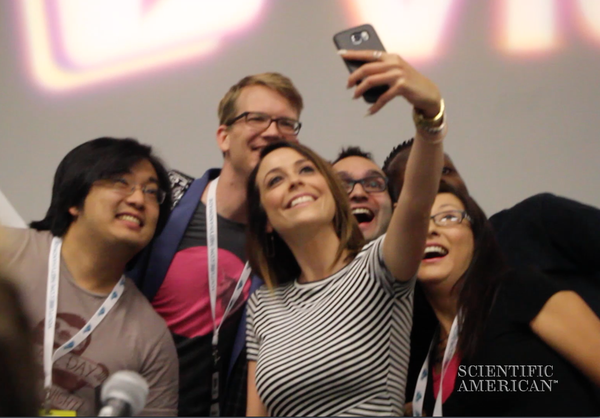This article was published in Scientific American’s former blog network and reflects the views of the author, not necessarily those of Scientific American
YouTube has exploded in the decade since it first launched in 2005, to the point where the top five most influential figures among American teens are all YouTube stars.
Alongside the young celebrity musicians, beauty gurus and pranksters, is an impressive lineup of science rock stars—scientists and communicators who have risen to Internet fame through their educational and personality-driven original content.
Last week at the world’s largest online video conference, VidCon (where YouTube celebrities are swamped with 20,000 screaming fans), these new faces on the frontlines of science communication were among the most famous and flocked to of all YouTube stars at the convention in Anaheim, California.
On supporting science journalism
If you're enjoying this article, consider supporting our award-winning journalism by subscribing. By purchasing a subscription you are helping to ensure the future of impactful stories about the discoveries and ideas shaping our world today.
With tens of millions of views per video and hundreds of millions of views overall, these science YouTubers have reached more young people than Carl Sagan and Neil deGrasse Tyson combined. By blending humor with their personal lives and irreverent style, these online identities are popularizing science in new ways. They are also playing an increasing role in advancing science literacy, combating the misappropriation of science, motivating young people and influencing informed public policy discussions.
With online video on track to make up 80 percent of Internet traffic by 2020, the influence of these personalities will grow ever stronger. So who are these science rock stars? Here are some of the top creators featured at the sixth annual VidCon.
Destin Sandin – Smarter Every Day
In between YouTube videos on his popular channel, Smarter Every Day, Destin Sandlin is also a Missile Flight Test Engineer at Redstone Arsenal. Sandlin has produced over 200 videos focusing on unusual physics phenomena, including topics such as “The Truth About Toilet Swirl” and “The Archer’s Paradox”. His videos regularly receive over 10 million views, and he has a legion of almost 3 million subscribers.
Emily Graslie – The Brain Scoop
Holding a bachelor’s degree in Studio Art, Emily Graslie’s channel, The Brain Scoop, has become the largest science channel hosted by a woman in all of YouTube. As the Chicago Field Museum’s first-ever Chief Curiosity Correspondent, Emily’s videos focus on the biological sciences, including topics such as “Horns vs Antlers” and how to preserve animal specimens. Graslie’s fascination with field science began after she started volunteering at the Philip L. Wright Zoological Museum as a university student. Emily is well known as an advocate for women in STEM fields, particularly women who want to share their expertise on YouTube. Her video “Where My Ladies At?” is The Brain Scoop’s most popular video, with almost a million views.
Mitchell Moffit and Greg Brown – AsapSCIENCE
“We're interested in inspiring people who maybe don't know a lot about science and think of it as this hard subject in school,” says Mitchell Moffit, one half of the Canadian duo behind AsapSCIENCE.
Unlike most science channels, Moffit and Greg Brown’s AsapSCIENCE avoids talking heads, instead communicating through a unique style of fast-action whiteboard drawings. This formula has done well for them—in just three years, the pair have racked up almost a half billion views.
AsapSCIENCE explains the everyday science behind pop culture phenomena. Its most successful video, “What Color Is This Dress?” gained almost 20 million views and was featured widely in online media outlets such as The Huffington Post. Moffit and Brown claim the ASAP in their channel name stands for “as simple as possible,” and many would argue that is exactly what their channel achieves.
Joe Hanson – It’s Okay To Be Smart
Joe Hanson’s catchphrase, “Science is awesome, and there’s so much of it to explore,” accurately sums up the type of content you’ll see on his channel It’s Okay To Be Smart. A host on PBS’s Digital Network, Hanson has almost half a million subscribers and over 20 million views, covering topics as wide reaching as “What is Déjà vu?” to “Your Salad is trying to Kill You”.
A self-proclaimed “white male” Hanson is also an advocate for the diversification of science and the inclusion of more women in STEM fields. His video “Your #ScienceWoman Heros” produced in conjunction with Amy Poehler’s Smart Girls, featured NASA scientists and female YouTube creators alongside Hollywood celebrities like Susan Sarandon.
Hank Green – SciShow, CrashCourse, Vlog Brothers
Hank Green is a former biochemist who holds a bachelor's degree in Biochemistry and a master's degree in Environmental Studies. He’s one half of a YouTube media empire that started with the Vlog Brothers (a channel he co-runs with his brother, author John Green), which today spans to include science channels such as Crash Course and SciShow.
Across all platforms, Green boasts a fan base approaching the 10 million mark, making him the leading power player in the science-on-YouTube space. His educational videos span the mundane (“What Causes Sunburn?”) to the controversial (“The Science of Anti-Vaccination”) and often involve music, finger puppets and celebrity guest hosts to get the message across.
Green is known as a thought leader of YouTube, calling today’s online stars “more legitimate sources of unbiased thought and information than the news,” and he may be right. Earlier this year, Green was invited to the White House to interview President Barack Obama after his 2015 State of the Union Address—a sign of the snowballing cultural influence of YouTube personalities.
